1994 PONTIAC GRAND-AM tow
[x] Cancel search: towPage 158 of 274
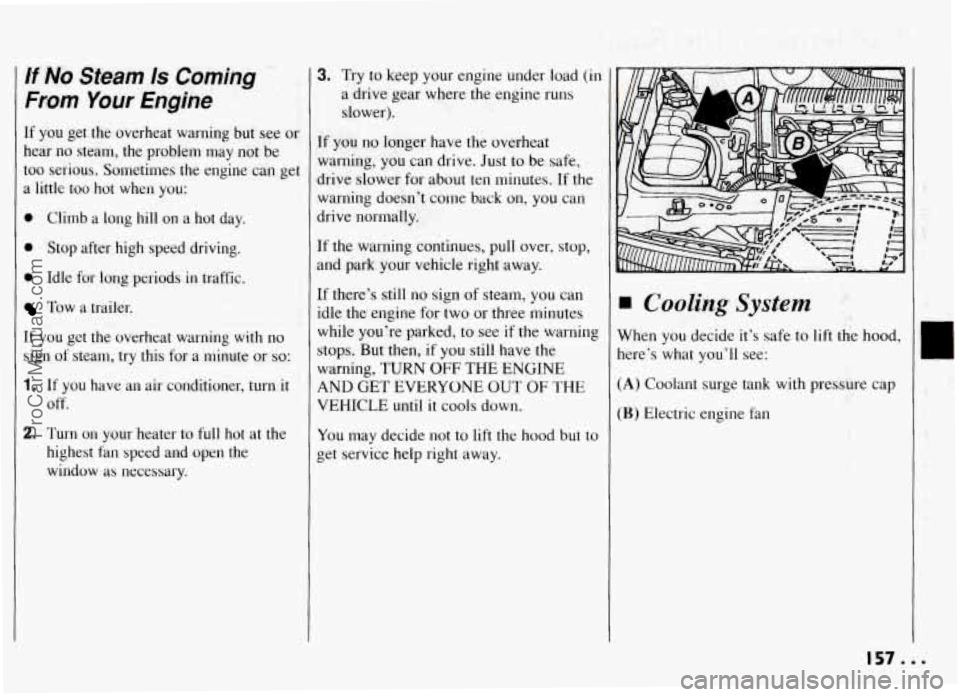
If No Steam 1s Coming
From Your Engine
If you get the overheat warning but see or
hear no steam, the problem may not be
too serious. Sometimes the engine can get
a little too hot when you:
0 Climb a long hill on a hot day.
0 Stop after high speed driving.
0 Idle for long periods in traffic.
Tow a trailer.
[f you get the overheat warning with no
sign of steam, try this for a minute or so:
1. If you have an air conditioner, turn it
off.
2. Turn on your heater to full hot at the
highest fan speed and open the
window as necessary.
3. Try to keep your engine under load (in
a drive gear where the engine runs
slower).
If you no longer have the overheat
warning,
you can drive. Just to be safe,
drive slower for about ten minutes.
If the
warning doesn't come back on, you can
drive normally.
If the warning continues, pull over, stop,
and park your vehicle right away.
[f there's still no sign of steam, you can
idle the engine for two or three minutes
while you're parked, to see
if the warning
stops. But then, if you still have the
warning, TURN
OFF THE ENGINE
4ND GET EVERYONE OUT
OF THE
VEHICLE until it cools down.
You may decide not to lift the hood but to
get service help right away.
Cooling System
When you decide it's safe to lift the hood,
here's what you'll see:
(A) Coolant surge tank with pressure cap
(B) Electric engine fan ii" , I .. i I. i. 4:. .;I'
.r': 5.
157...
ProCarManuals.com
Page 162 of 274
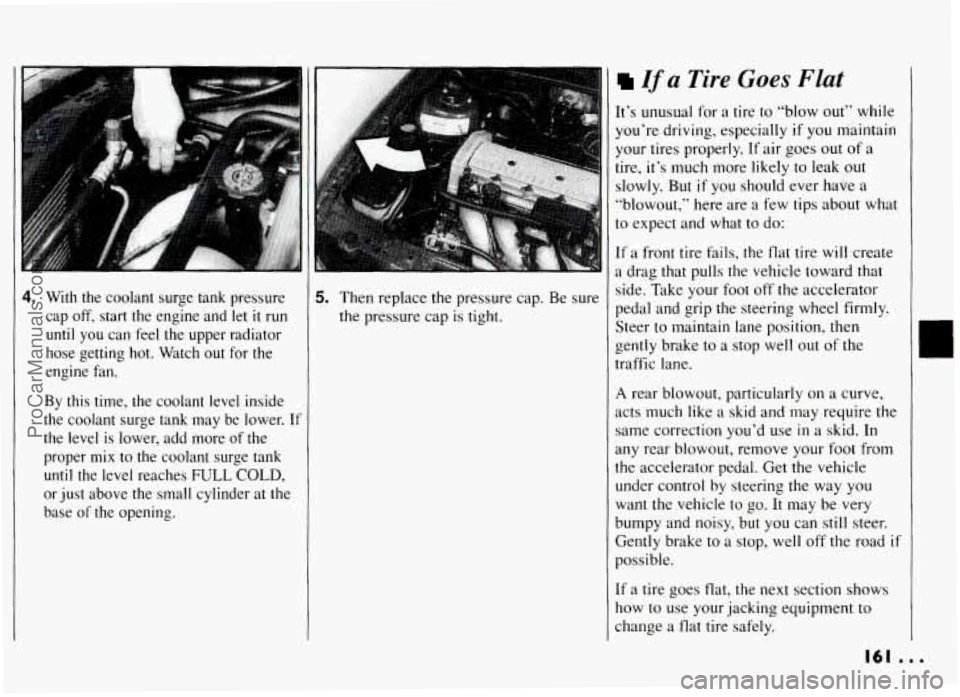
7
4. With the coolant surge tank pressure
cap off, start the engine and let
it run
until you can feel the upper radiator
hose getting hot. Watch out for the
engine fan.
By this time, the coolant level inside
the coolant surge tank may be lower. If
the level is lower, add more
of the
proper
mix to the coolant surge tank
until the level reaches FULL COLD,
or just above the small cylinder at the
base
of the opening.
I
5. Then replace the pressure cap. Be sure
the pressure cap is tight.
If a Tire Goes Flat
It’s unusual for a tire to “blow out” while
you’re driving, especially
if you maintain
your tires properly. If air goes out
of a
tire, it’s much more likely to leak out
slowly. But if you should ever have a
“blowout,” here are
a few tips about what
to expect and what to do:
If a front tire fails, the flat tire will create
a drag that pulls the vehicle toward that
side. Take your foot off the accelerator
pedal and grip
the steering wheel firmly.
Steer to maintain lane position, then
gently brake to
a stop well out of the
traffic lane.
A rear blowout, particularly on a curve,
acts much like a skid and may require
the
same correction you’d use in a skid. In
my rear blowout, remove your foot from
the accelerator pedal. Get the vehicle
under control by steering the way you
want the vehicle to go. It may be very
wmpy and noisy, but you can still steer.
Sently brake to a stop, well off the road if
Jossible.
[fa tire goes flat, the next section shows
low to use your jacking equipment to
:hange a
flat tire safely.
161 ...
ProCarManuals.com
Page 166 of 274

9. Remove any rust or dirt from the
wheel bolts, mounting surfaces or
spare wheel.
1O.Place the spare on the wheel mounting
surface.
11,.Replace the wheel nuts with thg
rounded.end of the nuts toward the
wheel. Tighten each nut
by hand until
the wheel
is held against the hub. ‘4 : d-;. .I !I .+ ..$:!7
p ,
165...
ProCarManuals.com
Page 169 of 274
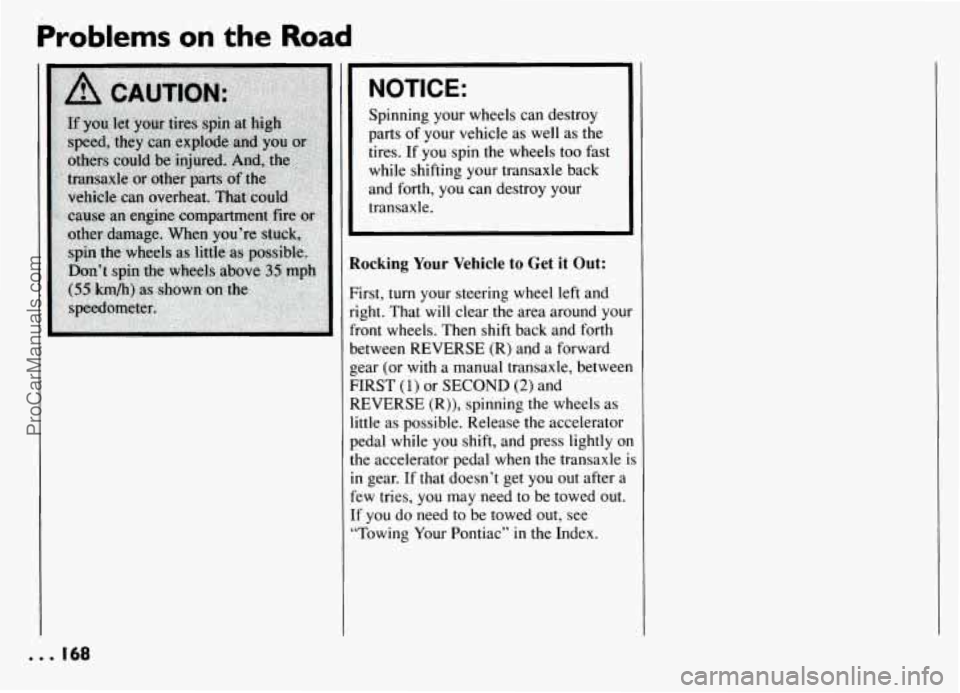
Problems on the Road
NOTICE:
Spinning your wheels can destroy
parts of your vehicle
as well as the
tires. If you spin the wheels too fast
while shifting your transaxle back
and forth, you can destroy your
transaxle.
..
locking Your Vehicle to Get it Out:
‘irst, turn your steering wheel left and
ight. That will clear the area around your
ront wheels. Then shift back and forth
letween REVERSE (R) and a forward
ear (or with a manual transaxle, between
IRST
(1) or SECOND (2) and
.EVERSE
(R)), spinning the wheels as
ttle as possible. Release
the accelerator
edal while you shift, and press lightly
on
le accelerator pedal when the transaxle is
1 gear. If that doesn’t get you out after a
:w tries, you may need to be towed out.
F you do need to be towed out, see
Towing Your Pontiac”
in the Index.
ProCarManuals.com
Page 180 of 274

Engine Oil
If the CHECK OIL light on the
instrument panel comes on,
it means you
need to check your engine oil level right
away. For more information, see “Check
Oil Light”
in the Index. You should check
the engine
oil regularly; this is an added
reminder.
It’s a good idea to check your engine oil
every time you get fuel. In order to get an
accurate reading, the oil must be warm
and the vehicle must be on level ground.
Turn off the engine and give the oil a few
minutes to drain back into the oil pan.
If
you don’t, the oil dipstick might not show
the actual level.
To Check Engine Oil
Pull out the dipstick and clean it with a
paper towel or cloth, then push
it back in
all the way. Remove it again, keeping the
tip lower, and check the level.
When to Add Oil
If the oil is at or below the ADD line, then
you’ll need to add some oil. But
you must
use the right kind. This section explains
what kind of oil
to use. For crankcase
capacity, see “Capacities and
Specifications” in the Index.
Adding Engine Oil
Just fill it enough to put the level
somewhere
in the proper operating range.
Push the dipstick all the way back
in
when you are through.
NOTICE:
Don’t add too much oil. If your
engine has
so much oil that the oil
level gets above the cross-hatched
area that shows the proper operating
range, your engine could
be
damaged.
179. . .
ProCarManuals.com
Page 183 of 274
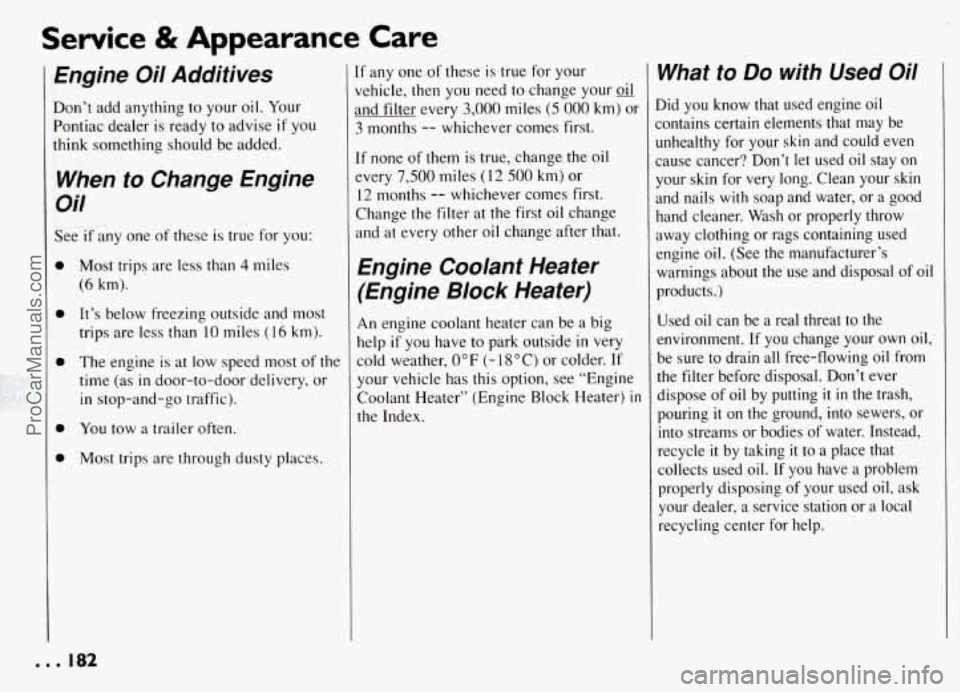
Service & Appearance Care
Engine Oil Additives
Don’t add anything to your oil. Your
Pontiac dealer is ready to advise
if you
think something should be added.
When to Change Engine
Oil
See if any one of these is true for you:
Most trips are less than 4 miles
(6 km).
It’s below freezing outside and most
trips are less than
10 miles ( 16 km).
The engine is at low speed most of the
time (as
in door-to-door delivery, or
in stop-and-go traffic).
You tow a trailer often.
Most trips are through dusty places.
[f any one of these is true for your
Vrehicle, then you need to change your oil
md filter every 3,000 miles (5 000 km) or-
3 months -- whichever comes first.
[f none of them is true, change the oil
=very 7,500 miles (12 500 km,) or
12 months -- whichever comes first.
Change the filter at the first oil change
and at every other
oil change after that.
Engine Coolant Heater
(Engine Block Heater)
An engine coolant heater can be a big
help if
you have to park outside in very
cold weather,
0°F (- 18OC) or colder. If
your vehicle has this option, see “Engine
Coolant Heater” (Engine Block Heater)
in
the Index.
What to Do with Used Oil
lid you know that used engine oil
:ontains certain elements that may be
Inhealthy
for your skin and could even
:awe cancer? Don’t let used oil stay on
your skin for very long. Clean your skin
md nails with soap and water, or a good
land cleaner. Wash or properly throw
lway clothing or rags containing used
mgine oil. (See the manufacturer’s
warnings about the use and disposal of oil
products.)
Used oil can be a real threat to the
mvironment.
If you change your own oil,
be sure to drain all free-flowing oil from
the filter before disposal. Don’t ever
dispose of oil by putting
it in the trash,
pouring
it on the ground, into sewers, or
into streams or bodies of water. Instead,
recycle
it by taking it to a place that
collects used
oil. If you have a problem
properly disposing of your used oil, ask
your dealer, a service station or
a local
recycling center for help.
... 182
ProCarManuals.com
Page 186 of 274
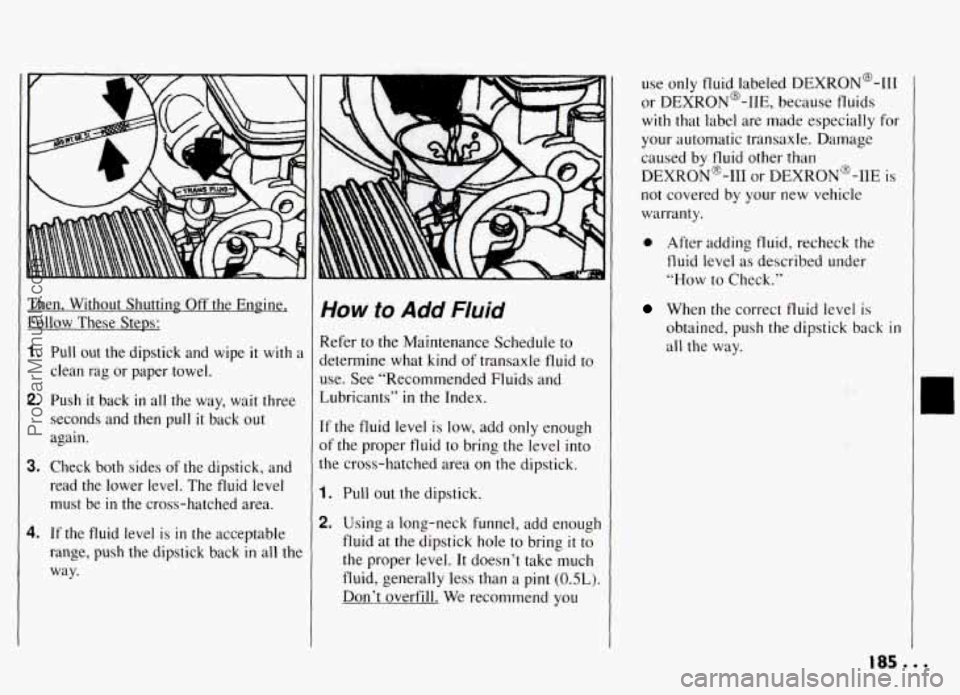
Then, Without Shutting Off the Engine,
Follow These Steps:
1. Pull out the dipstick and wipe it with a
clean rag or paper towel.
2. Push it back in all the way, wait three
seconds and then
pull it back out
again.
3. Check both sides of the dipstick, and
read the lower level. The fluid level
must be
in the cross-hatched area.
4. If the fluid level is in the acceptable
range, push the dipstick back in all the
way.
How to Add Fluid
Refer to the Maintenance Schedule to
determine what kind
of transaxle fluid to
use. See “Recommended Fluids and
Lubricants”
in the Index.
[f the fluid level is low, add only enough
of the proper fluid to bring the level into
the cross-hatched area on the dipstick.
1. Pull out the dipstick.
2. Using a long-neck funnel, add enough
fluid at the dipstick hole to bring it to
the proper level. It doesn’t take much
fluid, generally less than a pint
(OSL).
Don’t overfill. We recommend you
use only fluid labeled DEXRON@-111
or DEXRON@-IIE, because fluids with that label are made especially for
your automatic transaxle. Damage
caused by
fluid other than
DEXRON@-111 or DEXRON@-IIE is
not covered by your new vehicle
warranty.
0 After adding fluid, recheck the
fluid level as described under
“How
to Check.”
When the correct fluid level is
obtained, push the dipstick back in
all the way.
,. .. .. . ?!;i
.. !f ;
. : .
:,$ t * L .. ,, , ,, i
I85
ProCarManuals.com
Page 187 of 274

I Service & Appearance Care
Manual Transaxle
Fluid
When to Check
A good time to have it checked is when
the engine
oil is changed. However, the
tluid
in your manual transaxle doesn't
require changing.
How to Check
Because this operation can be a little
diftlcult,
you may choose to have this done
at a Pontiac Dealership Service Department.
If you do it yourself, be sure to follow a11
the instructions here, or you could get a
false reading on the dipstick.
NOTICE:
Too much or too little tluid can
darnage
your transaxle. Too much
can mean that some
of the tluid
could come out and fall
011 hot
engine parts or exhaust system,
starting a fire. Be sure
to get an
accurate reading
if you check your
transaxle fluid.
Check the tluid level only when your
engine IS off. the vehicle is parked on a
level place and the transaxle is
cool
enough for you to rest your fingers on the
transaxle case.
I
hen, Follow These Steps:
I Flip the handle up and the.n pull out
the dipstick and clean it with a rag or
paper towel.
2. Push it back in all the way and remove
It.
3. Check both sides of the dipstick and
read the lower level. The fluid level
must be between the
ADD and FULL
marks. (Note: Fluid may appear at the
bottom
of the dipstick even when the
tluid level is several pints low.)
4. If the tluid level is where it should be,
push the dipstick back in all the way
and flip the handle down. If the fluid
level is low. add more fluid as
described
in the next steps.
. .* 186
ProCarManuals.com